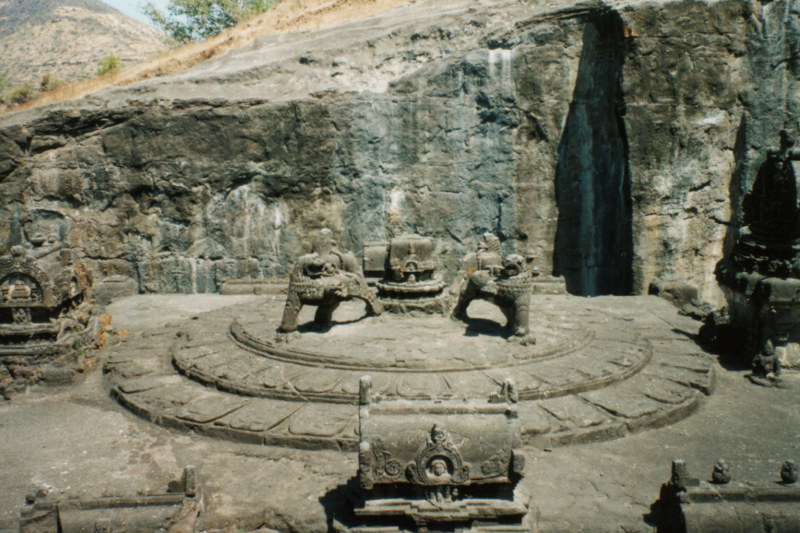Today’s journey was the Ellora Caves and Daulatabad Fort. I caught a bus and made my way up the plateau and past the Daulatabad Fort to the caves first. It was relatively easy to get there; there are buses every 10 minutes from Aurangabad and each one drops you off right at the mouth of the caves.
Cave 16 was definitely the most spectacular and the drop off point leads to that one first. It is a huge shrine to Shiva. The entire thing has been carved out of one rock from the top down. The details and the monuments are so perfectly planned it must have take years to do the planning alone. The idea was to build Mt. Kailash from a single stone and this is why it is called the Kailasnath temple. I found some of the murals interesting. One is of a gopi flaunting his power by shaking Shiva’s mountain home. Shiva is undaunted by this and steps on the gopi’s head and forces him into the ground. Shiva does a dance of victory.
The Buddhist caves contain an amazing assembly hall. Here there was one large Buddha in the back of the cave, large walls lined with Buddhas, and approximately 30 decorated pillars (I’m wondering if these are musical pillars). I discovered this cave quite by accident after stumbling upon a small staircase hidden behind one of the entry caves; no one else managed to discover the hall so I sat in the middle unhindered for quite while.
It was easy to catch a bus heading back to Aurangabad; but rather than go the whole way I got off in Daulatabad to see the fortress. The wall of the fortress is 5 km long and in the centre is a bastion on a cliff face 200m up from the main fort. This cliff or hill is known as Devgiri (hill of the gods).
The Sultan of Dehli in 1338 (Mohammad-bin-Tughlaq) was an eccentric man who orchestrated a plan to move the India capital city of Delhi to Daulatabad. He forced all his subjects to march the 1100 km south to the new capitol and in the process managed to kill many because of poor access to resources. He then decided a few years later to move back to Delhi.
I wandered around the fort for quite sometime and discovered hidden passageways (they lead you to the cliff face where the bastion stands), very dark and cold passageways, neat little booby traps (I swear it was like being on the set of an Indian Jones movie), big round balls that come out of the wall, places where soldiers could pour boiling water and tar on advancing troops, and even a few sudden shoots that lead to unknown areas. But apparently, despite all precautions in a completely Indian way, the fort was taken once by bribing the guard at the gate.
It was quite a climb to the top of the bastion. I can’t imagine what it was like for the poor guy who had to climb it everyday repeatedly to do the watch. The view was excellent and you can see the entire Deccan plateau.
On the way down I checked out the Chand Minar, the largest Victory tower in India (60 metres high). It was built in 1435 and at one point in time had its own miniature fortress around it — but alas there is little left of this after 550 years of wear and weather.
